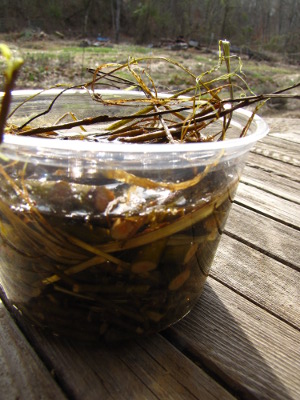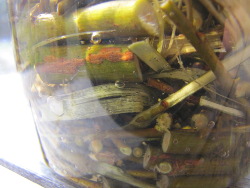
Homemade willow rooting hormone
 I've played
around with taking advantage of willows' natural rooting hormones in the past, but have never
gotten very serious about it. However, an actual tested recipe in
The
Reference Manual of Woody Plant Propagation (combined with some gifted
fig cuttings) prompted me to give it another try.
I've played
around with taking advantage of willows' natural rooting hormones in the past, but have never
gotten very serious about it. However, an actual tested recipe in
The
Reference Manual of Woody Plant Propagation (combined with some gifted
fig cuttings) prompted me to give it another try.

To make rooting hormone
tea from first-year willow twigs, just strip off leaves (if any are
present), cut the wood into small pieces, and cover them up with
water. After 24 hours of steeping, pour off the liquid and use it
immediately, or store it in your fridge for up to six years.
Since willow rooting
hormone isn't as strong as commercial preparations, it's best to let
the base of your cuttings sit in the willow juice for a day before
moving them to their rooting chamber. I'm treating half my fig
cuttings with willow rooting hormone and letting half sit in water for
a day as a control and will let you know if I see a difference in
rooting.
Want more in-depth information? Browse through our books.
Or explore more posts by date or by subject.
About us: Anna Hess and Mark Hamilton spent over a decade living self-sufficiently in the mountains of Virginia before moving north to start over from scratch in the foothills of Ohio. They've experimented with permaculture, no-till gardening, trailersteading, home-based microbusinesses and much more, writing about their adventures in both blogs and books.
Want to be notified when new comments are posted on this page? Click on the RSS button after you add a comment to subscribe to the comment feed, or simply check the box beside "email replies to me" while writing your comment.

De --- It's the best book I've found so far, although I haven't read them all. I'm going to do a lunchtime series on it soon to highlight the pros and cons.
Meanwhile, I looked up tea for you, and the book seems to recommend taking cuttings in July to August, treating with 1000 ppm IBA, and then rooting under mist. They note "This is an easy Camellia species to root."
Anna I'd recommend varying your soak time in the willow water. Such as cut fresh and dip for x minutes then try again.
I know a lot of Universities and Extension offices use Dip N Grow. The thing with Dip N Grow is the longer you let it soak the worse the cutting does. I believe for Dip N Grow they say no less than 5 seconds and no more than 1 minute.
Anyways just a thought I'd throw your way.
Enjoy!